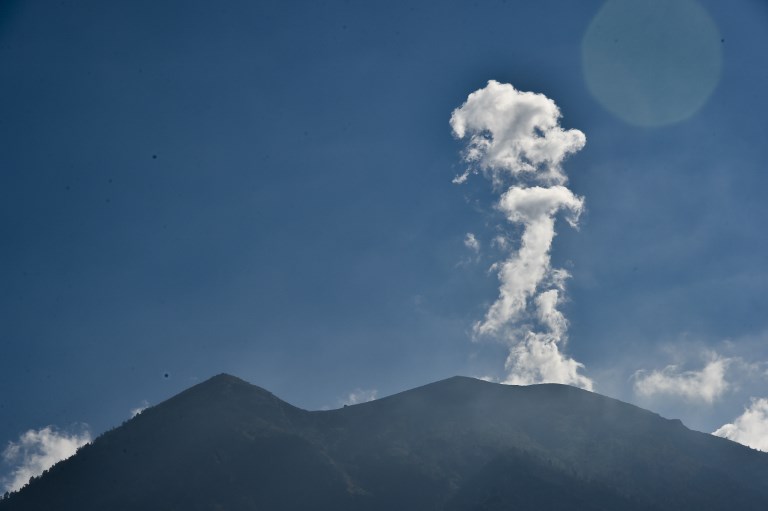Mount Agung has been demonstrating increasingly restless behavior. White steam clouds containing sulfurous fumes have been observed shooting up from the Bali volcano with more intensity.
Fears of an eruption are heightened as a fissure vent has also been spotted at the volcano’s crater.
Agung, 75 kilometers (47 miles) from the resort hub of Kuta, has been shaking since August and threatening to erupt for the first time since 1963–a potential blow to the island’s lucrative tourism industry, though the governor is still asking travelers to keep on coming. Tremors have been frequent (amounting to hundreds daily) and a 4.2 and 4.3 earthquake were recorded near the volcano this week.
The head of the Volcanology and Geological Disaster Mitigation Center (PVMBG), Gede Suantika, confirmed that there is a fissure vent, or crack at the crater of Agung.
The fracturing is an indicator that the volcano will likely soon erupt, says Suantika.
“It’s possible that the lava flow will come from there,” he said on Friday.
“This morning the steam billowed from the crater like the smoke that comes out of a factory chimney.
“Since the sulfurous fumes are out, the possibility of an eruption is getting more real.”
The PVMBG director also took the time to remind everyone that Mt. Agung is still at a level IV, critical alert level since being upgraded one week ago.
“In the past, the white steam could not be seen from a distance, it could only be seen from the crater. But now it can be seen from further away, so it means that the gas pressure is bigger,” he said.
PVMBG spokesperson Devi Kemil also confirmed that satellite images show a tear, or vent in the crater of Mt. Agung.
“In the middle, there is a small tear and there is smoke coming out of it,” Kemil said.
“But liquid lava has not yet come out.”
While magma has not yet been observed as coming to the surface, the presence of a fissure vent is often signal it’s likely on the way, says Kemil.
Satellite imagery also indicates that the volcano is becoming hotter and hotter: new steam emissions and thermal areas had been detected, according to the center.
But the spokesperson was quick to add that we still cannot know for sure if the volcano will erupt.
The head volcanologist at PVMBG, Kasbani, echoed this uncertainty.
“At this moment, the probability of an eruption is higher than the probability of no eruption; however, the probability may change,” he said.
The number of evacuees has topped 144,000, according to officials.
Around 62,000 people lived in the danger zone before the evacuations, according to Indonesia’s disaster mitigation agency, but residents just outside the area have also left out of fear.
If Agung erupts, it’s predicted that the volcano would hit the immediate surrounding area hard, taking quite a toll on existing infrastructure like roads, bridges, crops, and water supply.
The airport is currently at an orange alert level—the status was upgraded on Tuesday. Plans have been made to divert arrivals to 10 other airports in Indonesia should the airport’s status get upgraded to red, forcing the closure of Ngurah Rai International.
Reporting by AFP and Coconuts Bali




